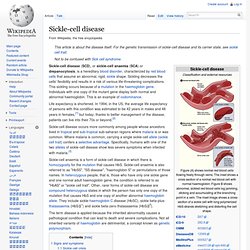

Sickle Cell Disease. Sickle Cell Disease, Data and Statistics - NCBDDD. Sickle cell disease (SCD) affects millions of people throughout the world and is particularly common among those whose ancestors came from sub-Saharan Africa; Spanish-speaking regions in the Western Hemisphere (South America, the Caribbean, and Central America); Saudi Arabia; India; and Mediterranean countries such as Turkey, Greece, and Italy.

Did you know? Sickle cell disease occurs more often among people from parts of the world where malaria is or was common. It is believed that people who carry the sickle cell trait are less likely to have severe forms of malaria. In the United States1 The exact number of people living with SCD in the U.S. is unknown. Sickle-cell disease. Sickle-cell disease (SCD), or sickle-cell anaemia (SCA) or drepanocytosis, is a hereditary blood disorder, characterized by red blood cells that assume an abnormal, rigid, sickle shape.

Sickling decreases the cells' flexibility and results in a risk of various life-threatening complications. This sickling occurs because of a mutation in the haemoglobin gene. Individuals with one copy of the mutant gene display both normal and abnormal haemoglobin. This is an example of codominance. Life expectancy is shortened.